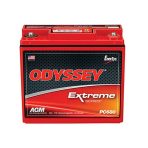Race Batteries & Accessories
Race Batteries & Accessories bring high CCA, low mass and compliant mounting. Start with proven packs in Race Batteries, maintain chemistry-correct charging via Battery Chargers, and protect the install with sealed Battery Boxes. Expect stable voltage for ECUs, pumps and data systems across full race weekends.
Brief summary & key benefits
Race Batteries & Accessories combine high cranking amps (CCA), low mass and compliant retention for reliable starts and clean power delivery. Motorsport brings vibration, heat cycles and frequent starts; lightweight AGM/VRLA and Li-Ion solutions keep voltage stable for ECUs, pumps and logging equipment, while proper enclosures and hardware prevent movement and shorts.
Technical Basics
Think of the system as battery + wiring + protection. Low-resistance packs deliver strong cranking and fast recovery; correct cable cross-section and solid grounds limit voltage drop. Multi-stage charging (analysis, bulk, absorption, float) reduces stress and improves longevity. For contact and short protection, use terminal boots, fuses close to the source and tidy routing. Accessory parts that simplify safe wiring and service are collected under Other Battery Accessories.
Selection Criteria
Size CCA to engine compression, displacement and ambient temperatures; choose capacity (Ah) for accessory demand. Packaging constraints (footprint, height, terminal orientation) influence enclosure choice and cable runs. If the car sits between events, plan for a chemistry-correct maintainer and consider fitting ring-terminal leads for quick hook-up. In wet or dusty conditions, prioritise ingress protection and abrasion/heat shielding for looms.
Use cases: time-attack builds often run compact but high-CCA units; high-compression or turbo engines benefit from higher CCA reserves; rally/off-road applications prioritise vibration resistance and rigid retention to survive repeated impacts.
Installation & Maintenance
Isolate the system before work. Connect positive then negative; reverse to remove. Use rigid mounts, torque to spec and cap terminals for touch protection. Keep grounds short and of adequate gauge; strain-relieve and route cables away from heat and sharp edges. For storage, use a compatible maintainer’s float mode and verify resting voltage before events. Hardware for secure multi-point retention is available in Battery Ties & Holders.
FAQ
Q: AGM or Li-Ion for racing?
A: AGM is robust and cost-effective; Li-Ion offers superior power-to-weight but must be charged with a lithium profile and used with appropriate protection.
Q: How much CCA do I need?
A: At least OEM guidance; increase for high-compression engines or frequent cold starts.
Q: Where should the main fuse go?
A: On the positive lead, as close to the battery as practical, to protect the entire run from shorts.
Q: Is long-term connection to a charger safe?
A: Quality multi-stage chargers in maintenance/float mode are designed for it—always follow the manual.






